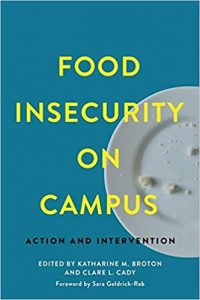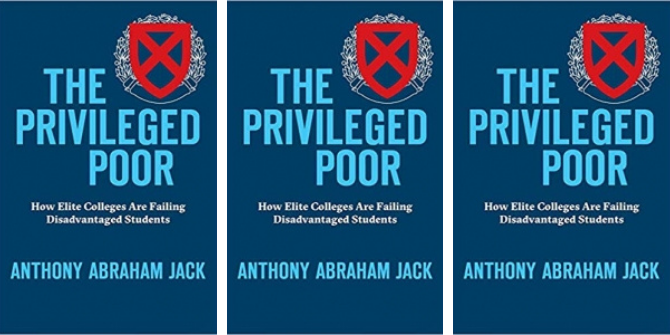In Food Insecurity on Campus: Action and Intervention, editors Katharine M. Broton and Clare L. Cady present background research and case studies from American college campuses that are in the fight to end hunger among their students, an issue only exacerbated by the COVID-19 pandemic. Policymakers, students and administrators are among those who can use these essays as a blueprint to implement change within their communities, writes Rebecca Howard.
Food Insecurity on Campus: Action and Intervention. Katharine M. Broton and Clare L. Cady (eds). Johns Hopkins University Press. 2020.
 Find this book (affiliate link):
Find this book (affiliate link): ![]()
The current student loan debt balance in the United States is over 1.6 billion US dollars with no sign of slowing down. The cost of college continues to rise as the purchasing power of federal student aid, such as the Federal Pell Grant, declines, leaving students with fewer resources to afford the cost of living. There is a significant body of research and recommended policy interventions to tackle the cost of college and the student debt crisis, from debt cancellation and free community college to increased accountability of colleges and universities.
To reckon with the growing price tag of higher education, colleges and stakeholders have been thinking creatively about how to address the costs students face outside of the classroom, such as food, housing and childcare. While the issue of food insecurity on campus is not new to many, it has been made abundantly clear thanks in part to the research done by the U.S. Government Accountability Office.
Unbeknownst to the editors at the time, Food Insecurity on Campus: Action and Intervention comes as COVID-19 shines a light on existing inequities that students and their families face on and off college campuses. Editors Katharine M. Broton and Clare L. Cady have edited a collection of essays that couple research with ongoing efforts at colleges and universities across the US in the hope that more schools and stakeholders will develop similar interventions. While evidence-based approaches to addressing campus hunger are still in the early stages, this book is the first of its kind to provide a comprehensive look at the various methods used to confront food insecurity in higher education (6-7).
Nonprofit leaders, college administrators and faculty as well as former students contribute detailed background and guidance on the steps they took to develop their intervention on campus or with a campus partnership. From campus food pantries to emergency grants, the editors provide the reader with a wealth of practices and programmes taking place at a variety of institutions, such as a community college, a university system and an alliance of colleges across the US. Such need for intervention often began with interactions with students or peers who were struggling to make ends meet.

Personal stories of those benefiting from campus interventions paint a powerful picture. Unfortunately, the trope of the ‘poor college student’ sustaining themselves on a ‘ramen noodle diet’, which is referenced throughout the book, remains a narrative that is harmful in many ways. Such thinking normalises and glosses over the essential needs of students, who often have to choose between feeding their families and remaining in school. As Jennifer J. Maquire and Rashida M. Crutchfield write in Chapter Eight, ‘there was a belief that the problem was unique to a few students and that addressing their unmet basic needs was not the responsibility of higher education’ (196).
One way to systematically reimagine how we help students in need is through data. In the first chapter, Broton states that although the data is not perfect, it is safe to assume that approximately half of undergraduate college students are food insecure (17). Student-level data collection on costs, graduation and outcomes is a tricky subject in the higher education world, but when collected and utilised in a meaningful way, it can be a powerful agent for change.
In Chapters Seven and Eight, a system-level, top-down approach is demonstrated when the former chancellor of the California State University system commissioned a study for a holistic understanding of the barriers that students face. As a result, all 23 campuses in California now have some form of food insecurity and basic needs intervention in the form of a food distribution system or food pantry.
In Chapter Nine, Amarillo College’s president, Russell Lowery-Hart, initiated a data assessment to track student success but quickly came to the realisation that poverty held students back more than academic challenges. Lowery-Hart instituted an entire culture change where every employee job description now lists ‘serve students’ (228) as the first item. Amarillo College now uses data analytics to assist students at risk of dropping out but they have also trained school personnel to identify warning signs in students.
Top-down or nonprofit interventions can often break through the campus bureaucracy but students play a unique role in creating action to combat food and housing insecurity. They are often more aware of the plight of their peers who may be a roommate, classmate or friend. In Chapter Six, students at Oregon State University began organising in the early 2000s to help fellow students and the Human Services Resource Center (HSRC) was born. It started as a one-stop hub for students to submit paperwork for the federal Supplemental Nutrition Assistance Program (SNAP), to acquire basic groceries, to take a shower and so on. As the needs have become more apparent, the HSRC has evolved over time to include textbook rentals, cooking classes and dedicated housing for those in emergency situations. Ongoing data and anecdotal collection has been critical for HSRC’s strategic growth.
Data and individual stories not only make a difference on campuses, but they also have the potential to impact local, state and federal policy. In Chapter Eight, former California assemblywoman Shirley Weber had an intern in her office struggling to use her SNAP benefits for on-campus dining. Weber decided to introduce legislation to allow for the proper machines to be installed on campus; however, she was met with pushback. Once the report from the California State University system was released, she was able to get that legislation and a number of other bills across the finish line.
This is just another example of how developing interventions and tracking data can impact more than one campus or one student. The editors and contributors admit there is no perfect solution to ending food insecurity on campuses. For one, it is linked to a greater problem of poverty in the United States. However, they acknowledge the limitations head on while suggesting changes that can be made on the local, state and federal level, specifically regarding SNAP, formerly known as food stamps.
Overall, this book is organised well for those unfamiliar with current research and strategies, yet is still illuminating to readers more familiar with the subject matter. The editors demonstrate through their choices of contributors that change can occur at all levels. While some information throughout is repetitious, the contributors present a compelling case that although data and evidence-based approaches are still emerging, this should not stop action. The more campuses and organisations intervene, the more students will succeed.
Note: This review gives the views of the author, and not the position of the LSE Review of Books blog, or of the London School of Economics. The LSE RB blog may receive a small commission if you choose to make a purchase through the above Amazon affiliate link. This is entirely independent of the coverage of the book on LSE Review of Books.
Image Credit: Photo by Storiès on Unsplash.







